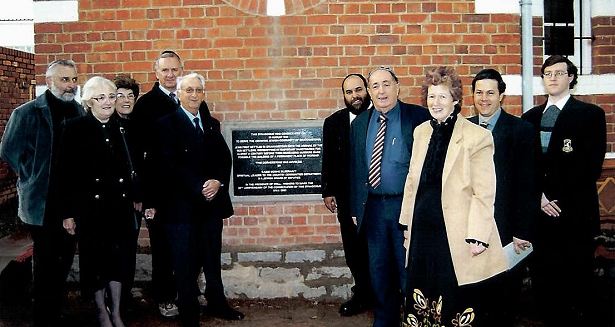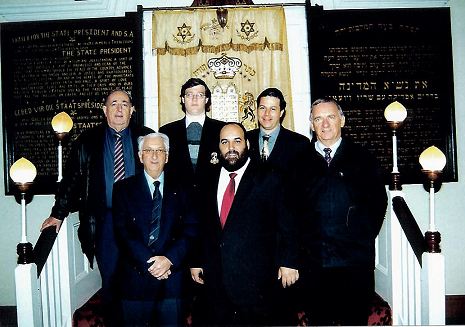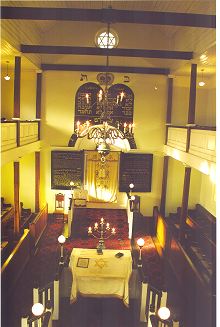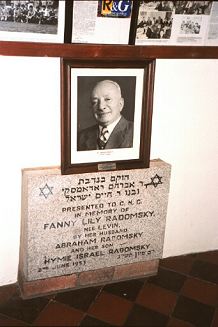|
A BRIEF HISTORY OF
GRAHAMSTOWN JEWRY 1820 -


  
Jews have been part of the
fabric of Grahamstown almost from the beginning. The first Jews
settled in what was then no more than an isolated frontier village
following the arrival of the 1820 Settlers. The history of this
congregation, one of the oldest organized Jewish congregations in
the country, can be divided into two distinct periods, an “Anglo”
phase, in which most of its members originated from Britain, and a
latter, “Litvak” phase, where they were mainly from Eastern Europe.
The first phase lasted until the 1870s, after which assimilation and
the decline of the town as a commercial centre saw the congregation
effectively ceasing to function. The later influx of east European
Jewish immigrants towards the end of the 19th century made possible
the revival of the community, which formally constituted itself as
the Grahamstown Hebrew Congregation on 1901.
In 1843 the Jewish community purchased a burial plot, which contains
the first recorded Jewish burial in South Africa. The new cemetery
was opened in the early 1940’s. The upkeep and maintenance of these
2 cemeteries are now under the supervision of the Country
Communities Department of the SAJBD.
In March 1902 a house in Beaufort Street was rented for religious
services. From 1905 until 1908 High Festival services were held in
the Masonic Hall, the Shaw Hall and in Mr Kaiser’s Hotel. The
building of a synagogue in Hill Street commenced in 1911 and in 1913
Rev A P Bender of Cape Town laid the foundation stone. Rev A Levy of
Port Elizabeth consecrated the building in 1914.
In 1927, £58 was spent on additions and alterations to the front of
the synagogue building. In 1939 at a cost of £600, the Masonic Hall
adjacent to the synagogue in Hill Street was purchased and converted
into a communal hall. The hall could accommodate over two hundred
people, with additional rooms that housed the local cheder and
Jewish Women’s organizations. 1953 saw the addition of a permanent
sukkah, situated behind the communal hall, which was donated by
Abraham Radomsky and his son Hymie in memory of wife and mother
Fanny Lily Radomsky. Both the communal hall and sukkah were sold in
1994 due to the decline of the Jewish community.
Jewish students studying at Rhodes University helped keep the
Grahamstown community active. In 1960, to cater for the growing
number of students, the S. A. Jewish Board of Deputies purchased a
house for the use of the Students' Jewish Association which later
became the S. A. Union of Jewish Students (SAUJS), in Somerset
Street. This remained the centre of Jewish student activity until
declining student members led to the sale of the property in 2002.
The Grahamstown Jewish Museum, established by SAUJS Rhodes students
in 1992, originally located at Hillel House was re-erected in the
foyer of the shul. Today, the Jewish student body is based at rented
premises in Beaufort Street, the same street in which a hundred
years ago the first minyanim of the new century were held.
In 2003 / 5763, in the presence of well-wishers, Rabbi Moshe
Silberhaft, Spiritual Leader to the S. A. Country Communities –
SAJBD, unveiled a new cornerstone to commemorate the 90th
anniversary of the Synagogue which is now, due to the decline in
numbers of the Jewish community, under the control of the Country
Communities Department of the SAJBD.
5763/2003
Dear Friends,
How goodly are thy tents, O Jacob, Thy dwelling places, O Israel”.
These say our Rabbis “are the Houses of Prayer and the House of
study” This inspiring verse, with which we open our daily order of
service, sings the praise of the Synagogue which, in an allegorical
way, called “The dwelling place of Israel”. A dwelling place unifies
the people who dwell therein and converts them into a family. It is
the joint home that is the attribute of a family. People remain
single, disjointed individuals as long as they do not occupy one
home.
What makes a congregation or a community out of a number of Jewish
individuals residing at a given place? What is the bond that unites
them and converts them into one organic group? Our Rabbis, in their
inspiring manner, have given the answer in the words of the Biblical
text: The dwelling place of Israel is in the Synagogue. It is the
Synagogue that is the focal point of communal life. What the home is
to the family, the Synagogue is to the Congregation. The home
cements the individuals together. It unites them in a common purpose
and a common ideal. It gives each one a sense of community and a
sense of belonging. It radiates warmth and encouragement. It gives
each one a sense of community and a sense of belonging. All this the
Synagogue has been to the Jew throughout the ages. It has cemented
the individuals and bound them together. It inspired them with a
common purpose and a common faith. It gives each one the strength
that goes with the feeling of membership of a group. It inspired
them with a faith in G-d and trust in His protection. Within its
walls they felt rested and re-invigorated and imbued with new
strength to face the hardships of life again. How goodly, indeed,
were those dwelling places for Israel!
The Grahamstown Synagogue has carried this sacred mission for 90
years now. It was the third synagogue to be built in South Africa,
following Cape Town and Port Elizabeth respectively.
It has helped to form an organized community out of the mass of
helpless pioneers who reached the shores of South Africa in search
of a new home and a new future. It has played a major role in the
progress, which the community has made.
Both in my personal capacity and on behalf of the Executive of the S
A Jewish Board of Deputies, heartiest congratulation to the
Grahamstown Synagogue for the services it has rendered to the Jewish
Community.
“May you never leave the minds, hearts and souls of all those who
have worshipped in your sacred walls”.
Rabbi Moshe Silberhaft
Spiritual Leader to S A Country Communities |